人教PEP版四年级英语上册《Unit1》精品教案教学设计小学优秀公开课13
- 格式:doc
- 大小:257.06 KB
- 文档页数:20
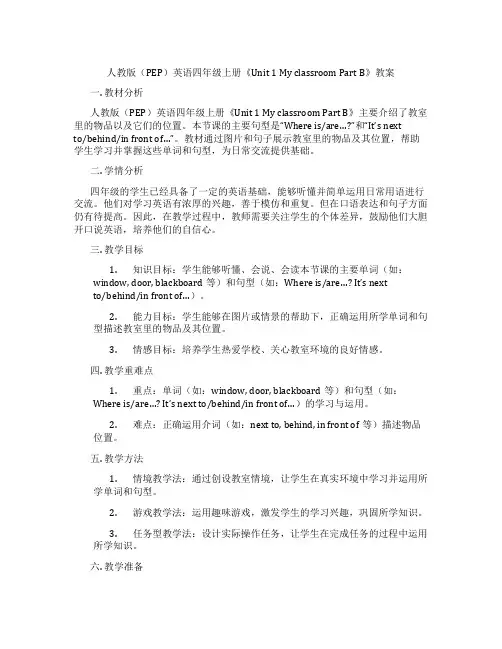
人教版(PEP)英语四年级上册《Unit 1 My classroom Part B》教案一. 教材分析人教版(PEP)英语四年级上册《Unit 1 My classroom Part B》主要介绍了教室里的物品以及它们的位置。
本节课的主要句型是“Where is/are…?”和“It’s nextto/behind/in front of…”。
教材通过图片和句子展示教室里的物品及其位置,帮助学生学习并掌握这些单词和句型,为日常交流提供基础。
二. 学情分析四年级的学生已经具备了一定的英语基础,能够听懂并简单运用日常用语进行交流。
他们对学习英语有浓厚的兴趣,善于模仿和重复。
但在口语表达和句子方面仍有待提高。
因此,在教学过程中,教师需要关注学生的个体差异,鼓励他们大胆开口说英语,培养他们的自信心。
三. 教学目标1.知识目标:学生能够听懂、会说、会读本节课的主要单词(如:window, door, blackboard等)和句型(如:Where is/are…? It’s nextto/behind/in front of…)。
2.能力目标:学生能够在图片或情景的帮助下,正确运用所学单词和句型描述教室里的物品及其位置。
3.情感目标:培养学生热爱学校、关心教室环境的良好情感。
四. 教学重难点1.重点:单词(如:window, door, blackboard等)和句型(如:Where is/are…? It’s next to/behind/in front of…)的学习与运用。
2.难点:正确运用介词(如:next to, behind, in front of等)描述物品位置。
五. 教学方法1.情境教学法:通过创设教室情境,让学生在真实环境中学习并运用所学单词和句型。
2.游戏教学法:运用趣味游戏,激发学生的学习兴趣,巩固所学知识。
3.任务型教学法:设计实际操作任务,让学生在完成任务的过程中运用所学知识。
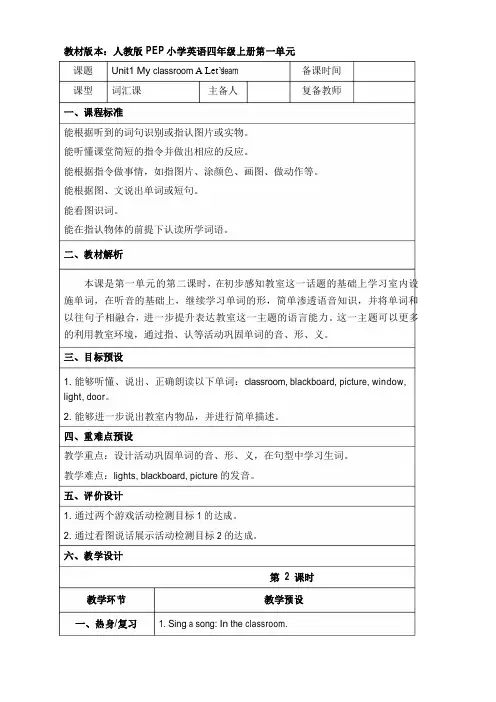
教材版本:人教版PEP小学英语四年级上册第一单元课题Unit1My classroom A Let’slearn备课时间课型词汇课主备人复备教师一、课程标准能根据听到的词句识别或指认图片或实物。
能听懂课堂简短的指令并做出相应的反应。
能根据指令做事情,如指图片、涂颜色、画图、做动作等。
能根据图、文说出单词或短句。
能看图识词。
能在指认物体的前提下认读所学词语。
二、教材解析本课是第一单元的第二课时,在初步感知教室这一话题的基础上学习室内设施单词,在听音的基础上,继续学习单词的形,简单渗透语音知识,并将单词和以往句子相融合,进一步提升表达教室这一主题的语言能力。
这一主题可以更多的利用教室环境,通过指、认等活动巩固单词的音、形、义。
三、目标预设1. 能够听懂、说出、正确朗读以下单词:classroom,blackboard,picture,window, light,door。
2. 能够进一步说出教室内物品,并进行简单描述。
四、重难点预设教学重点:设计活动巩固单词的音、形、义,在句型中学习生词。
教学难点:lights,blackboard,picture的发音。
五、评价设计1. 通过两个游戏活动检测目标1的达成。
2. 通过看图说话展示活动检测目标2的达成。
六、教学设计第2课时教学环节一、热身/复习教学预设1.Sing a song:In the classroom.(Warm-up/Revision)唱完歌曲后,教师根据歌曲内容引导学生回答巩固上节课所学内容。
T:What’s in the classroom?2.Show time.教师让学生组内展示自己绘制的教室图片,进行3-5句的简单介绍。
教师选取表达较为流畅的3-5人在班级进行展示。
教师将学生说出的好的句型进行板书归纳,引导学生借鉴学习。
如:This is my classroomIt’s big/beautiful/nice/small...We have a...1.学生描述过自己理想的教室后,教师利用现有教室的实际情况,引出新单词:classroom,blackboard,picture,window,light,door。
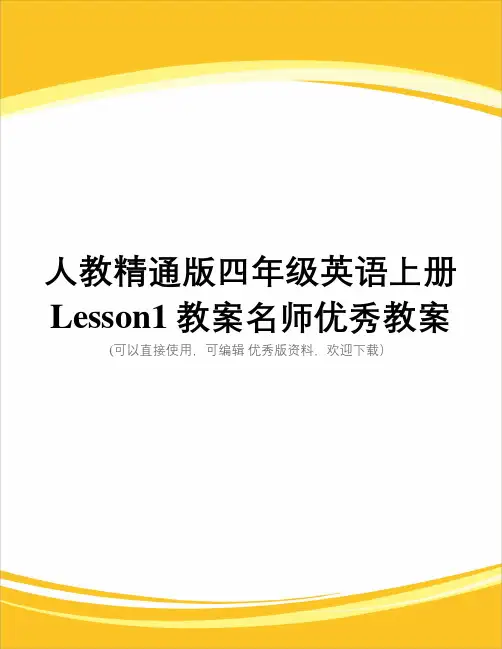
人教精通版四年级英语上册Lesson1教案名师优秀教案(可以直接使用,可编辑优秀版资料,欢迎下载)人教精通版四年级英语上册Lesson1教案宝坻区中小学英语课堂教学教案授课教师: 授课时间: 课题 Unit 1 Lesson 1课型 New本课要求学生能够听、说、认读单词America、England,能够听、说、教学内容读、写单词China,在对话交流的过程中完成目标语言的学习,最终引导学生分析能够运用目标语言I’m from…进行交际。
本节课是四年级英语第一节课,通过三年级的英语学习,孩子们已有一定的知识基础,为了吸引孩子们的注意力,在做教学设计时,我们既要遵循学情分析语言学习的规律,又应该把握儿童的心理特点,使英语学习成为一种愉快的学习体验。
教学目标(依据以下几个维度设计:语言知识、语言技能、学习策略、文化意识、情感态度) 语言知识:学习三个表示国家的单词:China、 America、 England介绍自己国籍的句型:I’m from…介绍新朋友的句型:This is my new friend.语言技能:能够在真实语境中运用所学表示国家的单词和句型简单交流。
学习策略:愉快教学法、情境教学法、活动教学法、小组合作法、师生互动教学法。
文化意识:通过学习国旗,培养学生的爱国情操。
情感态度:培养学生学习英语的兴趣,使学生充满探求新知的欲望,树立学好英语的信心,提高交际能力,体验合作的成就感。
学习三个表示国家的单词:China、 America、 England 介绍自己国籍的句型:I’m from… 教学介绍新朋友的句型:This is my new friend. 重难点教学方法合作学习法及手段教学过程(按Preparation-Presentation-Practice-Production-Summary流程设计)教学环节师生活动设计意图时间 Step 1 1)T:Good morning, boys and 利用师生问好,复习巩Preparation girls! Nice to see you again! 固再一次见面时的问候语,为学习新课做铺3min.垫。
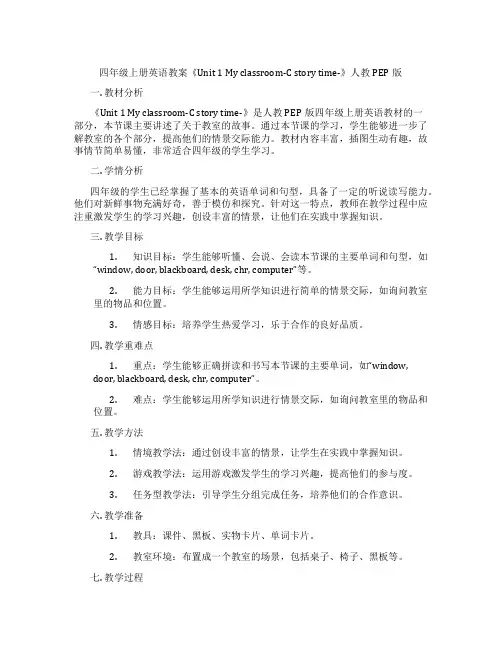
四年级上册英语教案《Unit 1 My classroom-C story time-》人教PEP版一. 教材分析《Unit 1 My classroom-C story time-》是人教PEP版四年级上册英语教材的一部分,本节课主要讲述了关于教室的故事。
通过本节课的学习,学生能够进一步了解教室的各个部分,提高他们的情景交际能力。
教材内容丰富,插图生动有趣,故事情节简单易懂,非常适合四年级的学生学习。
二. 学情分析四年级的学生已经掌握了基本的英语单词和句型,具备了一定的听说读写能力。
他们对新鲜事物充满好奇,善于模仿和探究。
针对这一特点,教师在教学过程中应注重激发学生的学习兴趣,创设丰富的情景,让他们在实践中掌握知识。
三. 教学目标1.知识目标:学生能够听懂、会说、会读本节课的主要单词和句型,如“window, door, blackboard, desk, chr, computer”等。
2.能力目标:学生能够运用所学知识进行简单的情景交际,如询问教室里的物品和位置。
3.情感目标:培养学生热爱学习,乐于合作的良好品质。
四. 教学重难点1.重点:学生能够正确拼读和书写本节课的主要单词,如“window,door, blackboard, desk, chr, computer”。
2.难点:学生能够运用所学知识进行情景交际,如询问教室里的物品和位置。
五. 教学方法1.情境教学法:通过创设丰富的情景,让学生在实践中掌握知识。
2.游戏教学法:运用游戏激发学生的学习兴趣,提高他们的参与度。
3.任务型教学法:引导学生分组完成任务,培养他们的合作意识。
六. 教学准备1.教具:课件、黑板、实物卡片、单词卡片。
2.教室环境:布置成一个教室的场景,包括桌子、椅子、黑板等。
七. 教学过程1.导入(5分钟)教师带领学生唱一首关于教室的英文歌曲,激发学生的学习兴趣。
然后向学生介绍本节课的主要内容,引出故事情节。
2.呈现(10分钟)教师通过课件或实物展示本节课的主要单词和句型,如“window, door, blackboard, desk, chr, computer”等。
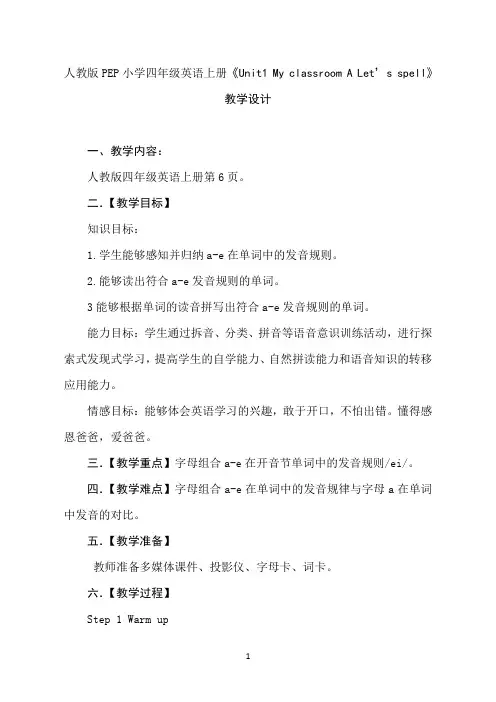
人教版PEP小学四年级英语上册《Unit1 My classroom A Let’s spell》教学设计一、教学内容:人教版四年级英语上册第6页。
二.【教学目标】知识目标:1.学生能够感知并归纳a-e在单词中的发音规则。
2.能够读出符合a-e发音规则的单词。
3能够根据单词的读音拼写出符合a-e发音规则的单词。
能力目标:学生通过拆音、分类、拼音等语音意识训练活动,进行探索式发现式学习,提高学生的自学能力、自然拼读能力和语音知识的转移应用能力。
情感目标:能够体会英语学习的兴趣,敢于开口,不怕出错。
懂得感恩爸爸,爱爸爸。
三.【教学重点】字母组合a-e在开音节单词中的发音规则/ei/。
四.【教学难点】字母组合a-e在单词中的发音规律与字母a在单词中发音的对比。
五.【教学准备】教师准备多媒体课件、投影仪、字母卡、词卡。
六.【教学过程】Step 1 Warm up1.Greetings and free talkT: Hello, boys and girls.Ss: Hello, teacher.T: Today ,I’ll divide you in to three groups.You are group 1,you are group 2,you are group 3.please listen carefully,speak loudly and clearly,read imotionally,write correctly,then you can get the star. Understand?Ss:Yes.2.A chant of the letter a.教师通过chant引导学生复习元音字母a的发音/æ/。
T: first, Let’s enjoy a chant of the letter a,then tell me “What words do you hear in the chant?”OK,Let’s go!Would you like to chant with me?Good,show me your finger,point and say.播放视频Ss: Hello, teacher.T:The chant is very nice,in the chant,What words do you hear?Ss: apple,ant,alligator,ax.T: apple, apple,a,aSs: /æ/设计思路:通过相互问候,拉近与学生的心理距离,产生亲近感,小组竞争将学生迅速带入一个英语的氛围之中。
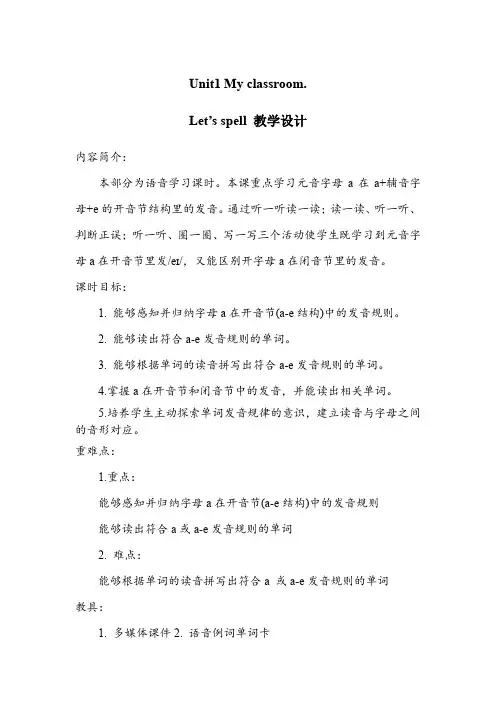
Unit1 My classroom.Let’s spell 教学设计内容简介:本部分为语音学习课时。
本课重点学习元音字母a在a+辅音字母+e的开音节结构里的发音。
通过听一听读一读;读一读、听一听、判断正误;听一听、圈一圈、写一写三个活动使学生既学习到元音字母a在开音节里发/eɪ/,又能区别开字母a在闭音节里的发音。
课时目标:1. 能够感知并归纳字母a在开音节(a-e结构)中的发音规则。
2. 能够读出符合a-e发音规则的单词。
3. 能够根据单词的读音拼写出符合a-e发音规则的单词。
4.掌握a在开音节和闭音节中的发音,并能读出相关单词。
5.培养学生主动探索单词发音规律的意识,建立读音与字母之间的音形对应。
重难点:1.重点:能够感知并归纳字母a在开音节(a-e结构)中的发音规则能够读出符合a或a-e发音规则的单词2. 难点:能够根据单词的读音拼写出符合a 或a-e发音规则的单词教具:1. 多媒体课件2. 语音例词单词卡教学流程:Step 1:Warm up1.Short vowel song (sing along with the tape)Step 2:Lead in and Presentation1.Picture:What’s this?It’s a fat cat.(贴图板书单词)2.Summarize the rules :a ,a, a(贴图), /æ//æ//æ/,再拼读/f/-/æ/-/t/,fat. / K/-/æ/-/t/,cat3.read more words with –a (师摆卡片h-a-t,s-a-d,生齐拼读),小结书写规律,a+辅!4.GroupworkIt’s a game ,play the game in groups.(The group leader make new words with the cards ,the membersread .)5.You make so many words ,some are not real words,maybe itmay come true one day.6.read the words on the board together!( fat, cat, hat,sad)设计意图:以short vowel song热身,复习a在闭音节中的读音!通过摆卡片读单词巩固并复习书写规律,帮学生建立音形对应为下一步的学习做好知识上的顺延和铺垫。
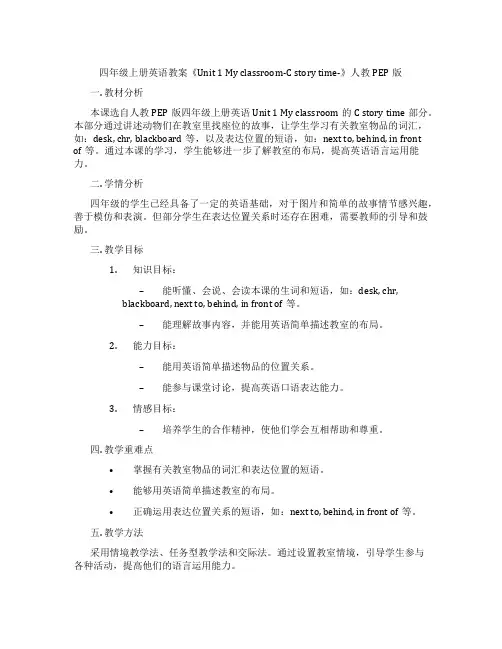
四年级上册英语教案《Unit 1 My classroom-C story time-》人教PEP版一. 教材分析本课选自人教PEP版四年级上册英语Unit 1 My classroom的C story time部分。
本部分通过讲述动物们在教室里找座位的故事,让学生学习有关教室物品的词汇,如:desk, chr, blackboard等,以及表达位置的短语,如:next to, behind, in frontof等。
通过本课的学习,学生能够进一步了解教室的布局,提高英语语言运用能力。
二. 学情分析四年级的学生已经具备了一定的英语基础,对于图片和简单的故事情节感兴趣,善于模仿和表演。
但部分学生在表达位置关系时还存在困难,需要教师的引导和鼓励。
三. 教学目标1.知识目标:–能听懂、会说、会读本课的生词和短语,如:desk, chr, blackboard, next to, behind, in front of等。
–能理解故事内容,并能用英语简单描述教室的布局。
2.能力目标:–能用英语简单描述物品的位置关系。
–能参与课堂讨论,提高英语口语表达能力。
3.情感目标:–培养学生的合作精神,使他们学会互相帮助和尊重。
四. 教学重难点•掌握有关教室物品的词汇和表达位置的短语。
•能够用英语简单描述教室的布局。
•正确运用表达位置关系的短语,如:next to, behind, in front of等。
五. 教学方法采用情境教学法、任务型教学法和交际法。
通过设置教室情境,引导学生参与各种活动,提高他们的语言运用能力。
六. 教学准备1.教材:人教PEP版四年级上册英语教材。
2.教具:图片、卡片、黑板、粉笔等。
3.课件:故事动画、图片等。
七. 教学过程1.导入(5分钟)–教师带领学生唱一首关于学校的英文歌曲,激发学生的学习兴趣。
–引导学生谈论学校里的教室和教室里的物品,为新课学习做好铺垫。
2.呈现(10分钟)–教师展示故事动画,让学生初步了解故事内容。
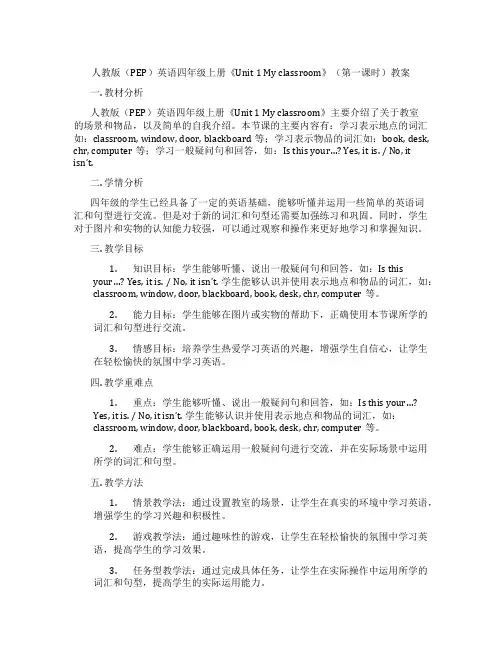
人教版(PEP)英语四年级上册《Unit 1 My classroom》(第一课时)教案一. 教材分析人教版(PEP)英语四年级上册《Unit 1 My classroom》主要介绍了关于教室的场景和物品,以及简单的自我介绍。
本节课的主要内容有:学习表示地点的词汇如:classroom, window, door, blackboard等;学习表示物品的词汇如:book, desk, chr, computer等;学习一般疑问句和回答,如:Is this your…? Yes, it is. / No, it isn’t.二. 学情分析四年级的学生已经具备了一定的英语基础,能够听懂并运用一些简单的英语词汇和句型进行交流。
但是对于新的词汇和句型还需要加强练习和巩固。
同时,学生对于图片和实物的认知能力较强,可以通过观察和操作来更好地学习和掌握知识。
三. 教学目标1.知识目标:学生能够听懂、说出一般疑问句和回答,如:Is thisyour…? Yes, it is. / No, it isn’t. 学生能够认识并使用表示地点和物品的词汇,如:classroom, window, door, blackboard, book, desk, chr, computer等。
2.能力目标:学生能够在图片或实物的帮助下,正确使用本节课所学的词汇和句型进行交流。
3.情感目标:培养学生热爱学习英语的兴趣,增强学生自信心,让学生在轻松愉快的氛围中学习英语。
四. 教学重难点1.重点:学生能够听懂、说出一般疑问句和回答,如:Is this your…?Yes, it is. / No, it isn’t. 学生能够认识并使用表示地点和物品的词汇,如:classroom, window, door, blackboard, book, desk, chr, computer等。
2.难点:学生能够正确运用一般疑问句进行交流,并在实际场景中运用所学的词汇和句型。
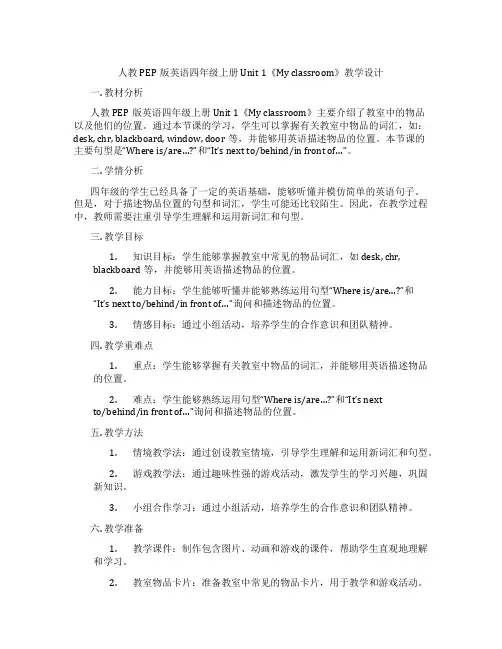
人教PEP版英语四年级上册Unit 1《My classroom》教学设计一. 教材分析人教PEP版英语四年级上册Unit 1《My classroom》主要介绍了教室中的物品以及他们的位置。
通过本节课的学习,学生可以掌握有关教室中物品的词汇,如:desk, chr, blackboard, window, door等,并能够用英语描述物品的位置。
本节课的主要句型是“Where is/are…?”和“It’s next to/behind/in front of…”。
二. 学情分析四年级的学生已经具备了一定的英语基础,能够听懂并模仿简单的英语句子。
但是,对于描述物品位置的句型和词汇,学生可能还比较陌生。
因此,在教学过程中,教师需要注重引导学生理解和运用新词汇和句型。
三. 教学目标1.知识目标:学生能够掌握教室中常见的物品词汇,如desk, chr,blackboard等,并能够用英语描述物品的位置。
2.能力目标:学生能够听懂并能够熟练运用句型“Where is/are…?”和“It’s next to/behind/in front of…”询问和描述物品的位置。
3.情感目标:通过小组活动,培养学生的合作意识和团队精神。
四. 教学重难点1.重点:学生能够掌握有关教室中物品的词汇,并能够用英语描述物品的位置。
2.难点:学生能够熟练运用句型“Where is/are…?”和“It’s nextto/behind/in front of…”询问和描述物品的位置。
五. 教学方法1.情境教学法:通过创设教室情境,引导学生理解和运用新词汇和句型。
2.游戏教学法:通过趣味性强的游戏活动,激发学生的学习兴趣,巩固新知识。
3.小组合作学习:通过小组活动,培养学生的合作意识和团队精神。
六. 教学准备1.教学课件:制作包含图片、动画和游戏的课件,帮助学生直观地理解和学习。
2.教室物品卡片:准备教室中常见的物品卡片,用于教学和游戏活动。
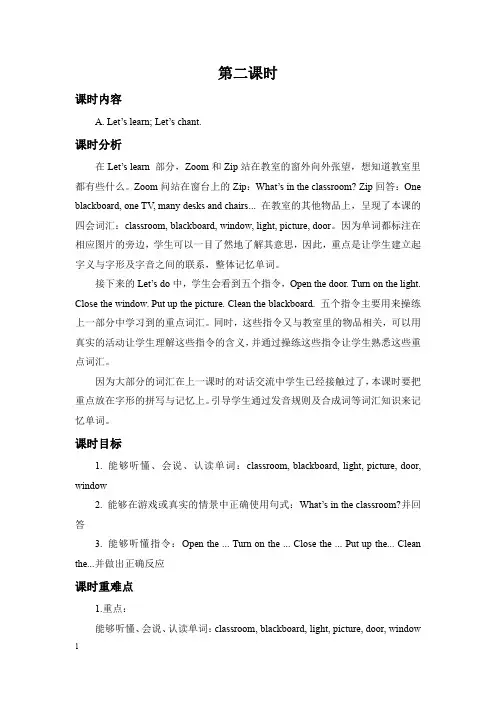
第二课时课时内容A.Let’s learn;Let’s chant.课时分析在Let’s learn部分,Zoom和Zip站在教室的窗外向外张望,想知道教室里都有些什么。
Zoom问站在窗台上的Zip:What’s in the classroom?Zip回答:One blackboard,one TV,many desks and chairs...在教室的其他物品上,呈现了本课的四会词汇:classroom,blackboard,window,light,picture,door。
因为单词都标注在相应图片的旁边,学生可以一目了然地了解其意思,因此,重点是让学生建立起字义与字形及字音之间的联系,整体记忆单词。
接下来的Let’s do中,学生会看到五个指令,Open the door.Turn on the light. Close the window.Put up the picture.Clean the blackboard.五个指令主要用来操练上一部分中学习到的重点词汇。
同时,这些指令又与教室里的物品相关,可以用真实的活动让学生理解这些指令的含义,并通过操练这些指令让学生熟悉这些重点词汇。
因为大部分的词汇在上一课时的对话交流中学生已经接触过了,本课时要把重点放在字形的拼写与记忆上。
引导学生通过发音规则及合成词等词汇知识来记忆单词。
课时目标1.能够听懂、会说、认读单词:classroom,blackboard,light,picture,door, window2.能够在游戏或真实的情景中正确使用句式:What’s in the classroom?并回答3.能够听懂指令:Open the...Turn on the...Close the...Put up the...Clean the...并做出正确反应课时重难点1.重点:能够听懂、会说、认读单词:classroom,blackboard,light,picture,door,window能够在游戏或真实的情景中正确使用本课单词及句式:What’s in the classroom?2.难点:能够听懂指令:Open the...Turn on the...Close the...Put up the...Clean the...并做出正确反应教学准备1.多媒体课件、录音机、磁带2.教室内物品的单词图卡教学过程✪Step1Warm up1.与学生互致问候之后,请学生注意自己带到教室里的物品,并根据其位置呈现韵句。

Unit1 My classroom 教学设计
己的教室。
Where is the ?
It is in/on/under/near the .
2.Let’s check
1)Listen and tick or cross.
教师播放录音,让学生根据听到的内容完成Listen and tick or cross.练习。
2)L ook and circle.
1教师利用课件把学生用书第10 页Look and tick or cross.部分教学挂图展示给学生,并提出问题让学生
回答:What’s in the classroom?
2学生回答完毕后,给出Look and circle.部分A 和B 两个答案,让学生选出正确的选项,并在自己书上
圈出来。
3.Story time
1)教师指着教室中的物品对学生说:There are so many things in our classroom. Look! There is a teacher’s desk. There is a picture on the wall. Can you tell me what else there are in our classroom?
教师引导学生用there is / are 的句式回答问题。
2 )教师分别利用课件出示单词fan, computer, light, teacher’s desk, chair, picture 等,让学生认读单词后回答教。
《Unit1 My classroom》优质教案1. A Let’s learn Let’s do B Let’s singTeaching aims and demands:1.The students will be able to master three-skill words: window, door, picture, blackboard,light and classroom.2.The students will be able to master some TPR expressions: Open the door. Turn on thelight. Close the window. Put up the picture. Clean the blackboard. Sweep the floor.3. The students will be able to master the question and the answer: What’s in the classroom? ….I.P: The students will be able to master three-skill words: window, door, picture, blackboard, light and classroom.D.P:1.Master some TPR expr essions: Open the door. Turn on the light. Sweep the floor. Clean the window. Put up the picture. Clean the board.2. The students will be able to master the question and the answer: What’s in the classroom? ….Teaching aids: cards, picture, tapeTeaching procedures:Step1. Warm-up/ Revision1. Free talk:Hello, how are you?Nice to meet you!What’s your name?What’s this? Point to desk/chair/door.2. Listen to the song on page 10 We have a new classroom3. Listen and do: Point to the desk/ chair/…. Show me your pencil/ ruler/….Step2. PresentationLet’s learn/ Let’s do1.T: What can you see in our classroom? How many ____can you see? ( chairs/ desks/ boys/girls/…) ---- Learn to say the new words: window, door, picture, board, light. Write them on the Bb.Look and read. Read and spell. Watch and read.2.Learn to say some phrases from Let’s do and make new phra ses:Open the door. ---- Open the book/ pencil-case/ window/ bag.Turn on the light.---- Turn on the fan/ radio/TV.Clean the window.---- Clean the board/ door / classroom/desk .Sweep the floor. Put up the picture.3.Look at the pictures of Let’s do, clap hands and say the phrases:e.g. T: Open, open, Ss: Open the door.4.Let’s do: listen to the tape, say and do.5.Practice: Listen and do./ Do and guess.Step3.Add activities1. Daily rite culture in the West: 1) Thank you. 2) Excuse me. 3) After you.2. Know about the occasions we often use these sentences.e.g. When someone helps you, you should say: Thank you.If you will interpret someone, you should say: Excuse me.When you let someone go first, you can say: After you. ( Lady first.) Step4. Consolidation and extension1. Review the new words.2. Ss do pair work and so the actions.3. A game:T: What’s in the classroom?S1: One blackboard.S2: One blackboard and six lights.S3: One blackboard, six lights and ….….Homework:Blackboard design:Unit 1 My classroomWhat’s in the classroom? One blackboard….Open the door. ---- Open the book/ pencil-case.Turn on the light.---- Turn on the fan/ radio/TV.Clean the window.---- Clean the board/ door / classroom/desk .Sweep the floor. Put up the picture.Teacher’s notes:Exercise notes:2. A Let’s talk Let’s play B Let’s sing C Story timeTeaching aims and demands:1.The students will be able to master the dialogue.2.The students will be able to master the sentences: We have a new classroom. It’s so big.Let’s go and see. We have 6 new lights. Where is it? It’s near th e window. and use in daily life.3. The students will be able to talk about the things in the classroom and talk about the position.4. The students will be able to understand the story and read it correctly.I.P:1.The students will be able to master the dialogue.2. The students will be able to master the sentences: We have a new classroom. It’s so big. Let’s go and see. We have 6 new lights. Where is it? It’s near th e window. and use in daily life.D.P: The students will be able to talk about the things in the classroom and talk about the position.Teaching aids: cards, picture, tapeTeaching procedures:Step1. Warm-up/ Revision1.T shows the pictures and let the students say the words.2.Let’s do. Simon says.3.Talk about the classroom: What’s in the classroom? Guide them to talk about theclassroom. A board, four lights, many desks and chairs…. Practice the words: light, door, window, picture, board, classroom.Step2. PresentationLet’s tal k1. Write class ____ class_____ on the Bb. Ask Ss how to spell classroom. T: In the classroom, we can see many school things. And we also can see many students and teachers. You are students and you are classmates. Ask if they know classmate and how to spell it. Teach classmate and new. Practice saying: our new classmate. Introduce the new classmate, if there is.2. T: We have a new classroom. Have Ss to practice saying: We have ______. Help them totell we and I.3. T guides them to talk about the school things in the classroom. Then T asks about the position: Where is the blackboard? Help them to answer: It’s on/near the wall/window.4. T: Sarah and Zhang Peng have a new classroom, too. Let’s go and see. Do the gestures and say. Have Ss do and say with T.5. Listen the tape and read after it. Read by roles.6. Ask: Where’s my seat? Help Ss answer: It’s near the door. Practice saying: Where’s my seat? Pay attention to the pronunciation of Where’s and seat. Compare my and your. Ask: Where’s your seat? Help Ss to answer with It’s near the _____.Step3.Activities1. Listen to the tape and practice the dialogue. Try to act it out.2. Try to make a new dialogue about their own classroom.Let’s sing1.Listen to the song.2.Learn to say the sentences. ( t here’s/ there are)3.Say the song follow the tape.Step4. Consolidation and extension1. Do activity book A let’s talk.2. Practice the dialogue.Story time:1.T shows a little animal and guides them to guess: What is it? Then show them: It’s a bee.The bee can fly. Sometimes the bee flies into our classroom. And there is a bee in Zoom and Zip’s classroom, too.2.T plays the story.3.Ss repeat the story.Homework:Blackboard design:Unit 1 My classroomWhere is it?It’s near the door. In \on\undernew We have a new classmate/ classroom.Teacher’s notes:Exercise notes:3. A Let’s spellTeaching aims and demands:1.The students will be able to know and find out the pronunciation of the letter group a-e.2. The students will be able to read the words with the letter group a-e.3. The students will be able to spell and write the words with the letter group a-e.I.P:1.The students will be able to know and find out the pronunciation of the letter group a-e.2. The students will be able to read the words with the letter group a-e.D.P: The students will be able to spell and write the words with the letter group a-e. Teaching aids: cards, picture, tape.Teaching procedures:Step1. Warm-up/ Revision1.Review Let’s talk.2.Talk about the classroom.Step2. Presentation1. Read and listen and chant:1) T shows a boy and says: Look at this boy. He is our new classmate. What’s his name? His name is Jake. And T writes the name on the blackboard. T guides them to spell like this: / /-/ /-/ / / / /-/ /-/ / / /Then T shows another b oy named Dave. And spell the name like this: / /-/ /-/ / / / 2) T shows a cake and says: Jake and Dave make a cake. Then T guide them to spell the words make and cake in the same way.3) T shows some other words with a-e and guide them to spell and sum up the pronunciation of the letter group a-e.4) Listen to the tape and repeat. Listen to the chant and follow it.2. Read, listen and tickT plays the tape and students tick the right words.3.Listen, circle and write T plays the tape, Ss circle and write the words.Step3.Consolidation and extension1.T shows a bag and a hat. T: This is my bag. This is my hat. Then guides them to spell thewords. Then guide them to guess: What’s in my bag/hat? Oh, it’s a cake/cat.2.Then T shows a short passage: My name is Kate. This is my cap. What’s in my cap? A catin my cap. Oh, I hate the cat. What’s in my bag? A cake in my bag. I make the cake. I like to eat the cake. Oops, look at my face. T asks them to read the passage.Homework:Blackboard design:Unit 1 My classrooma-e / /cake face name makeTeacher’s notes:Exercise notes:4. B Let’s talk Let’s playTeaching aims and demands:1.The students will be able to listen, say and use the sentences: Let me/Let’s …. And knowhow to respond.2.The students will be able to know the sentence pattern: Let….3.The students will be able to understand the meaning of the words: the teacher’s desk, cleanand help.I.P: The students will be able to listen, say and use the sentences: Let me/Let’s …. And knowhow to respond.D.P: The students will be able to understand the meaning of the words: the teacher’s desk, clean and help.Teaching aids: cards, picture, tape.Teaching stepsStep1. Warm-up/ Revision1. Sing a song: We have a new classroom2. Let's do(1)Listen and do: Let’s do. P5(2)the students say verb phrases and do the actionStep 2 Presentation & Practice1. (1) T: we all love our new classroom. So we should keep it clean.Write: cleanThe classroom is clean. / we have to clean the classroom.(2)T: What can we clean?clean the deskclean the teacher’s desk(3)picture of a fishbowlT: It's a fishbowl. What can you do with the fishbowl?Clean the fishbowl.(4)T: There are some things to clean in our classroom. I can't clean them by myself. Let’sclean them together.Write: let’s = let usLet me, let her, let you…(5)Group workSay sentence: Let…+ verb phrases2. Pair work: I say, you doOne student say the pictures and so the actions. The other says the verb phrases.3. Let’s talk(1)Listen to the tape for 3 times and imitate(2)Read the talk in groups and act4. Let’s playChoose 6 phrases in a group. And then make up a dialogue.Step 3 Extension & Consolidation1. Let’s doChoose one phrase and do the action2. T: Can you find more things to do in our classroom? Maybe you can help your classmates or me.Step 4 Summing up1. Words: window, teacher's desk, let, clean2. SentencesLet me clean the teacher's desk.Let's clean the classroom.Homework:Blackboard design:Unit 1 My classroomLet's clean the classroom.Let me clean the teacher's desk.Let me help you.Teacher’s notes:Exercise notes:5. B Let’s learn Colour and sayTeaching aims and demands:1.The students will be able to listen, say and understand the sentences “This is the newclassroom. The door is orange”.2.The students will be able to master the three-skill words: fan, computer, te acher’s desk,wall and floor.3.The students will be able to describe the classroom with the colour words and the newwords learnt in this lesson.I.P: The students will be able to master the three-skill words: fan, computer, te acher’s desk, wall and floor.D.P: The students will be able to describe the classroom with the colour words and the newwords learnt in this lesson.Teaching aids: cards, picture, tape.Teaching stepsStep1. Warm-up/ Revision1. Main scene:(1)-We have a new classroom,-What's in your classroom?-I see a...-Where's. . . ?-It's. . .(2)-Let me clean the…-OK.2. Describe the classroomI have a new classroom. It is _______. I see ______in it. The______ is near the______.The ______is …Step 2 Presentation & PracticeLet’s learn(1) T :I have some new things in the new classroomPicture of fan: write “fan”. Learn it.(2)Learn the new words in the same way: computer,te acher’s desk,wall,floor(3)Game: give the missing wordsShow the new words for a few seconds and then one missing. The students give the missing word.(4)Listen to the tape and imitate the sounds of the words.Step 3 Extension &Consolidation1. What's different?Show two pictures of the classrooms and say the differences2. Colour and sayT : It's a new classroom, But it's not very beautiful. I need some colours to make it beautiful. Can you paint it?Colour and say in groups and then describeS:I have a new classroom. It is big. It is clean. The door is ______.The floor is ______. We have 40 desks and chairs. We have a The floor is In our classroom. I like my new classroom. Step 4 Summing up1. Words and phraseteacher's desk , computer , fan, wall, floor , chair, window2. SentencesThis is my classroom.The door is yellow.HomeworkBlackboard designUnit 1 My classroomLook! This i s the new classroom. The door is orange…teacher's desk computer fan wall floorTeacher’s notes:Exercise notes:6. B Read and write Let’s checkTeaching aims and demands:1. The students will be able to mater the sentence: Where is…? And respond correctly.2.The students will be able to master the four-skill words: window, desk, chair, floor, walland door.3.The students will be able to finish the exercises in let’s check.I.P: The students will be able to master the four-skill words: window, desk, chair, floor, wall and door.D.P: The students will be able to mater the sentence: Where is…? And respond correctly.Teaching aids: cards, picture, tape.Teaching stepsStep1. Warm-up/ Revision1. Review the words.2. Show picture of classroom and describe:This is a______ .The ______is ______(颜色) . Step 2 Presentation & PracticeRead and write1. Read and tick or cross.Read the sentences and understand themRead and tick or cross2. Look, choose and write.(1)Look at the pictures and answer:Where is the bag?Where is the newspaper?Where is the computer?(2)Spell the words: desk ,chair,window (3)Finish the sentences(4)Look, choose and write(5)Write about your classroomWhere is the ______?It is in/on/under/near the ______.Step 3 Extension &ConsolidationLet's check(1)Listen and tick or crossQ: What are they doing?Q: a. What can you see in this picture?b. What colour are they?c. How many desks can you see?Q:a. What can you see?b. Where is the fan?c. What colour is the window?(2) Look and circle.a. what’s in the classroom?b. Look and circle. Homework: Blackboard design:Unit 1 My classroom Where is the. .. ?It is in/on/under/near the. . . Teacher’s notes:Exercise notes:。
Unit1My clasroom教学设计Part B let’s learn教学内容:本部分主要学习关于教室内部设施的单词和短语:computer,fan,wall, floor teacher’s desk。
教学目标:使学生能够听,说,认读关于上述单词;并能够熟练描述教室中各种物品的颜色。
教学重点:使学生能够听,说,认读关于:computer,teacher’s desk,fan,wall,floor 单词,并能用英语简单描述教室。
如:This is my classroom The wall is white.The floor is green…教学难点:使学生能够用英语表达名词复数结构的句子。
如:The desks are green。
教具准备:1.自制与教材相配套的教学课件2.自制单词卡3.自制颜色转盘4.教室内部结构图片。
教学过程:(一)热身、复习(Warm-up/Revision).教师出示自制的颜色大转盘,一个学生拨动上面的指针,使转盘转动。
当转盘停止后,让大家说出指针所指的颜色。
再让另一个学生继续转动转盘,直到所学的有关颜色的单词(red,yellow,green,blue,purple,white,black,orange,pink, brown)都被复习过一遍。
(二)呈现新课(Presentation)1.课件呈现教室照片。
T:Look!This is the new classroom.What’s in the classroom?学生利用所学知识回答问题。
学生:One door,one blackboard......学生可能会说有一台电脑,这时教师可以指着电脑问学生:What’s this?引出新词“computer”,呈现电脑图片和单词,学习新词,并操练新词。
然后教师指着电脑问学生:What colour is the computer?学生答,教师板书单词。
(操练方法:个体读,小组读,群体读)2.以此类推分别教学教室中的地面,墙,风扇,讲台桌。
人教PEP版英语四年级上册Unit 1《My classroom》教案一. 教材分析人教PEP版英语四年级上册Unit 1《My classroom》主要介绍了教室中的不同物品以及它们的英文表达。
通过本节课的学习,学生能够听、说、读、写关于教室物品的英语单词和句型,提高他们的英语交际能力。
教材内容丰富,贴近学生生活,有利于激发学生的学习兴趣。
二. 学情分析四年级的学生已经掌握了基本的英语语音、词汇和简单的句子结构,具备一定的英语听说读写能力。
但部分学生在发音、词汇拼写和语法方面仍需加强。
此外,学生对实物的认知和描述能力有所提高,但还需要在课堂上通过大量的实践来提高他们的英语交际能力。
三. 教学目标1.知识目标:学生能够听、说、读、写关于教室物品的英语单词和句型,如:book, pen, pencil, ruler, desk, chr, blackboard, window, door等。
2.能力目标:学生能够在日常生活中运用所学单词和句型进行简单的描述和交流。
3.情感目标:培养学生热爱学习、积极参与课堂活动的态度,增强他们的自信心。
四. 教学重难点1.重点:学生能够听、说、读、写关于教室物品的英语单词和句型。
2.难点:单词的准确发音、拼写和语法运用,以及在实际情境中的运用。
五. 教学方法1.情境教学法:通过设置教室情境,让学生在真实环境中学习和使用英语。
2.互动教学法:引导学生积极参与课堂活动,提高他们的英语交际能力。
3.游戏教学法:通过趣味性强的游戏,激发学生的学习兴趣,巩固所学知识。
六. 教学准备1.教具:教室物品图片、单词卡片、课件等。
2.教学场地:教室。
1.导入(5分钟)教师带领学生唱一首关于教室的英文歌曲,激发学生的学习兴趣。
然后提问:“Can you guess what we are going to learn today?”,引导学生猜测本节课的主题。
2.呈现(10分钟)教师展示教室物品的图片,如:book, pen, pencil, ruler, desk, chr, blackboard, window, door等,并引导学生用中文描述这些物品。
人教PEP版 四年级英语上册Unit 1 My classroom第一课时Part A(Let's talk —Let's play)Dog:Where is my schoolbag?Monkey:It's near the computer.Chen Jie:Let me clean the desks andchairs.John:Let me clean the windows. 我的书包在哪?在电脑附近。
我来打扫桌椅。
我来擦窗户。
Cat:Let me clean the fish bowl.Sarah:Hey, Zhang Peng. We have anew classroom.Amy:Excuse me.Wu Yifan:Oh, sorry.让我来擦擦鱼缸。
嘿,张鹏。
我们有新教室了。
不好意思。
哦,对不起。
Sarah:Hey, Zhang Peng. We have anew classroom.Zhang Peng:Really? What's in the classroom?Sarah: Let's go and see!嘿,张鹏。
我们有新教室了。
真的吗?教室里有什么?我们去看看!Zhang Peng:It's so big!好大!Sarah: Look! My picture!看!我的照片!Zhang Peng:Where is it?在哪?Sarah:It's near the window.离窗户很近。
I see a “c”.Where is it?It's in a desk.It's a crayon.单词新朋友classroom 教室 really 真的picture 图画near距离近window 窗户句型新朋友We have a new classroom.我们有一个新的教室。
Let’s go and see.让我们去看看。
Unit 1 My Classroom教案Teaching objectionsKnowledge objections:1.master the knew words “classroom” “window” “door” “light” “blackboard” .2.Learn the sentence “What’s in the classroom?” and know how to answer this sentence.Talent objections:1.can use the new words and new sentence in our daily life2.Can tell others what’s in our classroomEmotional objection:1.let students love our classroom and our schoolT eaching Aids: PPT cards picturesTeaching Methods:Audio lingual Method; Presentation; Discussion; Question-answerImportant points:1.The pronunciational of the new words2.How to answer the sentence “What’s in the class room?”Teaching proceduresStep1.warming up1.GreetingsT: Good morning , boys and girls.S:Good morning, Annie.T:How are you?S:Fine , thank you.T:Are you happy today?S: Yes.T: Let;s sing a song ,OK?2.Sing The song Teddy BearStep2.PreviewShow some pictures and review the words we have learnStep3.Presentation1.Teacher show the toy teddy bear and say “ Today one of our good friend come to our classroom. Look ,he is .....? S:.............T: Now Teddy bear is a student,just like you. And he has new classroom. Let’s see his new classroom.( let students look at the PPT,teacher show a picture)2.Write down the topic “My classroom” and let students guess the meaning of “class room”. And then show the card of classroom. Let students touch the card and read the word.3.Show the picture of “door” and ask students “How many doors in our classroom?” “What colour is it?”e the same means learn the words “window” “picture” “desk” “light”5.Learn the sentence “what’s in the classroom?” and learn how to answer this sentence.Then let students find what’s in the classroom.Step4.Practice1.Games“寻找卡片”(教师藏起一张单词卡,当寻找者靠近卡片所藏地时,班级其他学生读单词卡上的声音就越大,远离时,声音就小)2.Let’s doListen to the radio and act “Open the door””Turn on the light””Close the window” “Put up the picture”Step5. Consolidation and Extension1.Group work (discuss what’s in the classroom and then have a PK)2.Review the words and the sentenceStep6.Homework1.Draw a picture about our classroom2.Tell your patents about what's in your classroom3.2.Read the new wordsBlackboard Design。